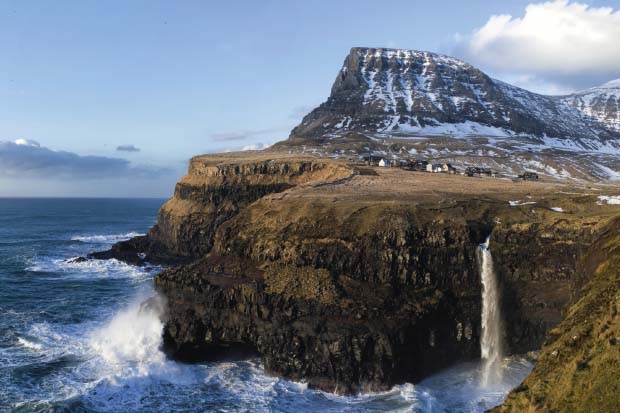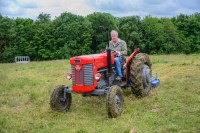‘Have a good holiday, Camilla. Don’t kill any whales.’ That’s not the normal goodbye I get when leaving the office, but then I’m not normally off to the Faroe Islands. The country isn’t that far from the UK — in fact, we’re the nearest neighbour, with Scotland 200 miles to the south. But it’s not somewhere people know much about. If they have heard of the Faroe Islands, the one thing they know about is the ‘grindadráp’, or pilot whale-hunt, which supplies newspapers with gory photographs every year.
Although I wouldn’t have been surprised to see whale on the menu (as you do in Norway), I hadn’t expected whaling to play much of a part in my trip. But on our second day, driving along a winding -coastal road, we turned a corner to see a large grey ship anchored in the fjord below, flying what looked like a Russian flag. Around the next we spotted a Danish frigate moored in the town of Vestmanna. Ready for the Russians, perhaps? Wrong. It turns out that my flag identification skills aren’t up to much. The flag was a Dutch flag, and the boat, the MV Sam Simon (named after the co-creator of The Simpsons), in fact belonged to Sea Shepherd, a ‘conservation society’. Every summer they sail a couple of boats to the Faroes with the aim of saving whales from the grindadráp. This year their campaigns resulted in the arrest of five campaigners — ‘the Sandavágur 5’ — and the seizure of three Sea Shepherd boats, one by Police Scotland while it refuelled in the Shetlands.
Killing whales is an emotive subject, and most locals are unwilling to talk about it. The antis, on the other hand, love sharing grisly images on social media. Ever since the islands were first inhabited in around 500 ad, the inhabitants have earned their keep from the sea, and it’s the same today. There’s little else here to make money from. There are sheep, it’s true — twice as many sheep as there are people. The livestock, like the people, must be hardy. On the most inaccessible cliffs, sheep are lowered on ropes at the beginning of the summer, and winched back up and moved to their winter grazing spots come autumn.
Apart from the sheep, it’s mostly about the sea. The islands are dotted with churches — almost all of them wooden, many of them with turf roofs — and each graveyard is testament to the dangers of living here, in the middle of the North Atlantic. ‘Lost at sea’, reads one epitaph. Another, simply ‘Drowned’. On Christmas Eve in 1913, a storm at sea killed many, including the entire male population of one village, Skarð, save for a 70-year-old man and two children. The boat which hangs from the ceiling of the Christianskirkjan church in Klaksvík is one of the few that returned that night.
The Faroes airline Atlantic Airways (with a total of five aircraft) has added an Edinburgh–Tórshavn flight to its summer -schedule, so the islands are now fairly easy to get to. It’s not an ideal summer holiday destination: in July the temperature was around 11˚C, and it was windy and rainy. It’s even wetter than Scotland, raining on an average 300 days a year, so don’t forget your waterproof.
Most people come for the birdwatching. Over the past 60 years, global seabird populations have declined by 70 per cent, but you wouldn’t know it here. On boat trips from Vestmanna you can see the birds as they take their places on the 1,500 foot-high cliffs above you — puffins at the top, razorbills and guillemots further down. Great skuas, storm petrels and gannets are around too, while the national bird, the oystercatcher, is everywhere.
The rocky landscape is dramatic; volcanic stacks emerge straight out of the sea, and look strangely prehistoric. To get the best views, buy a ticket for the domestic helicopter service that ferries locals from island to island, but also carries tourists as long as there’s space. In the air, it hits home how tough it must be to live here — although the population has tripled since the beginning of the 20th century to 48,000 people, so it can’t be all bad. In Viking times it must have been an entirely different proposition. The Saga Museum in Vestmanna (‘the only wax museum in the Faroe Islands’) gives an insight into life in the 11th century — tales of drownings, executions and bloody ghouls.
The Vikings might seem a long way back, but the bleakness of the landscape and the old-fashioned way of life make you feel very far from mainland Europe. The language, Faroese, reminded me of university days struggling to translate the strange runes of Old Norse into English. ‘A cow licked the salt, and out of the salt came a man? That can’t be right…’. Many of the place names come straight out of the sagas, and you can vividly imagine a longboat emerging from the mist.
The Faroes don’t have the geysers of Iceland, nor do they look likely to become a foodie hotspot like Copenhagen. You don’t go there for nightlife (though the receptionist in the Hotel Hafnia did warn us that in Tórshavn, ‘the world’s smallest capital’, things can get pretty rowdy on a Saturday. Well, they are Viking descendents). But the passion for all things Nordic shows no sign of abating, and if you want to be a step ahead, the Faroe Islands are the destination to watch.







Comments